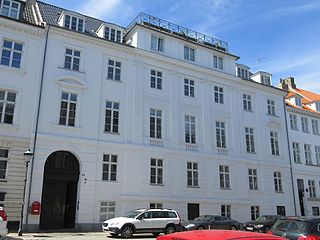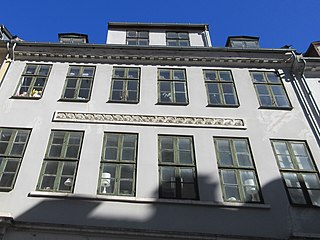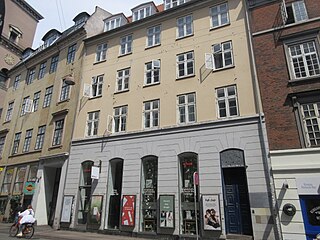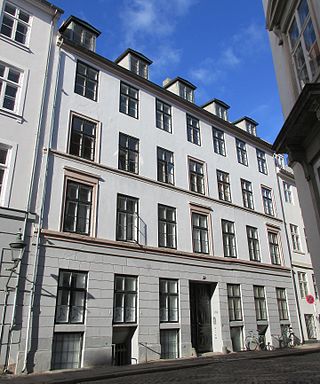
Stelling House is a building on Gammeltorv in the centre of Copenhagen, Denmark. Completed in 1937, it was designed as an office building and retail store for the A. Stelling paint company by Arne Jacobsen who took pains to have it blend in with the older buildings which surround it.

The Gustmeyer House is a historic property on Ved Stranden, opposite Christiansborg Palace on Slotsholmen, in central Copenhagen, Denmark. It was built in 1797 to a Neoclassical design by Johan Martin Quist. The Nobel Prize-winning physicist Niels Bohr was born in the building. McKinsey & Company is now based in the building.

Nyhavn 15 is a historic townhouse overlooking the Nyhavn Canal in central Copenhagen, Denmark. The building was listed in the Danish registry of protected buildings and places in 1945.

Gammel Strand 50 is a Neoclassical building overlooking Slotsholmens Kanal in central Copenhagen, Denmark. It was constructed as part of the rebuilding of the city following the Copenhagen Fire of 1795. The building was listed on the Danish registry of protected buildings and places in 1918. Notable former residents include the musician Holger Simon Paulli, chemist Christen Thomsen Barfoed and author Hans Vilhelm Kaalund-

Amaliegade 45 is a Neoclassical property situated at the northern end of Amaliegade in the Frederiksstaden district of central Copenhagen, Denmark. It is part of a row of adjoining buildings constructed at the site by master builder Andreas Hallander in the 1780s but owes its current appearance to an adaptation most likely undertaken by Jørgen Henrich Rawert in 1801. The building was owned by the painter Martin Rørbye's parents from 1817. His first significant painting, View from the Artist's Window, from c. 1825, shows the view from the family's apartment on the second floor. It was listed on the Danish registry of protected buildings and places in 1918.

Admiralgade 19 is a Neoclassical property situated off Nikolaj Plads in central Copenhagen, Denmark. The building was like most of the other buildings in the neighborhood constructed as part of the rebuilding of the city after the Copenhagen Fire of 1795. It was listed in the Danish registry of protected buildings and places in 1945.

Fortunstræde 1 is a Neoclassical property situated at the corner of Fortunstræde and Admiralgade, opposite the former St. Nicolas' Church, now Kunsthallen Nikolaj, in central Copenhagen, Denmark. The building was like most of the other buildings in the area constructed after the Copenhagen Fire of 1795. It was shortly thereafter acquired by the bookseller Abraham Soldin who in partnership with his brother Salomon Soldin ran a bookshop and publishing business from the premises. The venture was later continued by his son Ferdinand Vilhelm Soldenfeldt as F. V. Soldenfeldt. The building is today owned by Borgervennen, a fraternal society founded in 1788, now based in the apartment on the first floor. The building was listed in the Danish registry of protected buildings and places in 1945.

Rosenborggade 10 is a Neoclassical property situated at the obtuse corner of Rosenborggade and Sankt Gertruds Stræde, close to Nørreport station, in the Old Town of Copenhagen, Denmark. It was constructed in 1801 by Lauritz Laurberg Thrane, one of the most prolific master builders in Copenhagen during the 1790s and 1800s. It was listed in the Danish registry of protected buildings and places in 1979. Former residents include the composer Johan Christian Gebauer and the portrait painter Geskel Saloman.

Fiskebløderhuset is an 18th-century building situated at the corner of Gråbrødretorv and Niels Hemmingsens Gade in the Old Town of Copenhagen, Denmark. It was listed in the Danish registry of protected buildings and places in 1924. A fiskebløder was a special type of fishmonger, specializing in the soaking and selling of stockfish. Together with the adjacent buildings at Gråbrødretorv No. 3–9, the building is one of the best preserved examples of the so-called "fire houses" which were constructed as part of the rebuilding of the city following the Copenhagen Fire of 1728. A limestone tablet above the main entrance commemorates the fire.

Kompagnistræde 2 is a Neoclassical property situated at the corner of Kompagnistræde and Hyskenstræde, part of the shopping street Strædet, in the Old Town of Copenhagen, Denmark. It was listed in the Danish registry of protected buildings and places in 1964. Former residents include the poet Christian Winther.

Toldbodgade 5 is a 17th-century property situated in Toldbodgade, off Nyhavn in central Copenhagen, Denmark. It was listed in the Danish registry of protected buildings and places in 1977. The composer Carl Nielsen and the sculptor Anne Marie Carl-Nielsen resided in the apartment on the first floor from 1898 to 1906.

Nørregade 4 is an early 19th-century property situated in Nørregade, between Frue Plads and Gammeltorv, in the Old Town of Copenhagen, Denmark. The building was listed in the Danish registry of protected buildings and places in 1945.

Kompagnistræde 24 is a Neoclassical property situated on Strædet, between Knabrostræde and R¨dhusstræde, in the Old Town of Copenhagen, Denmark. It was constructed as part of the rebuilding of the city following the Copenhagen Fire of 1795 and later heightened with one storey in 1849. The building was listed in the Danish registry of protected buildings and places in 1979. Notable former residents include the artist Janus Laurentius Ridter.

Overgaden Oven Vamdet 20 is a canal house overlooking Christianshavn Canal in the Christianshavn neighborhood of central Copenhagen, Denmark. Built for a former ship captain in 1802, it stands four storeys tall and just three bays wide. It was listed in the Danish registry of protected buildings and places inn 1918. Notable former residents include the zoologist Jørgen Matthias Christian Schiødte.

Store Kannikestræde 15 is a Neoclassical property situated at the corner of Store Kannikestræde and Lille Kannikestræde in the Old Town of Copenhagen, Denmark. It was listed in the Danish registry of protected buildings and places in 1950. A plaque on the facade commemorates the fact that Peter Faber was a resident in the building when he wrote Højt fra træets grønne top in 1847. Other notable former residents include the landscape painter Thorald Læsøe, printmaker Søren Henrik Petersen (1788-1860), historian Caspar Frederik Wegener and illustrator Peter Christian Klæstrup.

Skindergade 32/Fiolstræde 2 is a Neoclassical apartment building situated at the acute corner of Skindergade and Fiolstræde in the Old Town of Copenhagen, Denmark, designed and constructed by master mason Thomas Blom in 1837–38as his last independent work. He went with a somewhat outdated Neoclassical style, undoubtedly to make the building blend in with Christian Frederik Hansen's Trøstens Boliger, Church of Our Lady and Metropolitan School on three adjacent sites. The building was listed in the Danish registry of protected buuildings and places in 1945. Notable former residents include the mathematician Christian Ramus, judge and later professor of law at the University of Copenhagen Tage Algreen-Ussing, lawyer Lars Christian Larsen, director of the Zealand Railway Company Viggo Rothe and bookseller and publisher G.E.C. Gad.

Nyhavn 53, also known as Madame Tofte's House, is a residential building overlooking the Nyhavn canal in central Copenhagen, Denmark. It was constructed with three storeys in the 1750s but owes its current appearance to a renovation in the 1870s. It was listed in the Danish registry of protected buildings and places in 1932. Notable former residents include the composer Peter Arnold Heise and the ballet dancer Augusta Nielsen. The Adventurers' Club of Denmark is based in a half-timbered warehouse in the courtyard.

Boldhusgade 2/Admiralgade 26 is a Neoclassical apartment building situated at the corner of Boldhusgade and Admiralgade in the Old Town of Copenhagen, Denmark. The building, like most of the other buildings in the area, was constructed as part of the rebuilding of the city following the Copenhagen Fire of 1795. Notable former residents include the army officer Bernhard Ditlef von Staffeldt. The building was later home to first the restaurant and bar venue Admiral-Krien and then the experimental theatre Boldhus Teatret. The building was listed in the Danish registry of protected buildings and places in 1939.

Admiralgade 28 is a Neoclassical building situated at the corner of Admiralgade and Boldhusgade in the Old Town of Copenhagen, Denmark. Constructed in 1798–99 by the prolific master builders Philip Lange and Lauritz Laurberg Thrane as part of the rebuilding of the city following the Copenhagen Fire of 1795., it is now part of a large complex of ministerial buildings which comprises the entire block. The building was listed in the Danish registry of protected buildings and places in 1950. Copenhagen's Student Association (Studenterforeningen) was based in the building from 1824 to 1831 and again from 1742 to 1863. Other notable former residents include the music retailers and publishers CCarl Christian Lose den ældre, merchant and Cherry Heering-manufacturer Peter Heering and the graphical studio Pacht & Crone.

Admiralgade 22 is a Neoclassical apartment building situated close to Nikolaj Plads in Copenhagen, Denmark. It was constructed in 1845–46 for a wholesale merchant named Harboe for whom Ved Stranden 16 on the other side of the block was also heightened by one storey. The two buildings was at the same time divided into two separate properties. Admiralgade 22 was listed in the Danish registry of protected buildings and places in 1959. The scope of the heritage listing was extended in 1988. Notable former residents include the ballet dancer Adolph Stramboe.
























